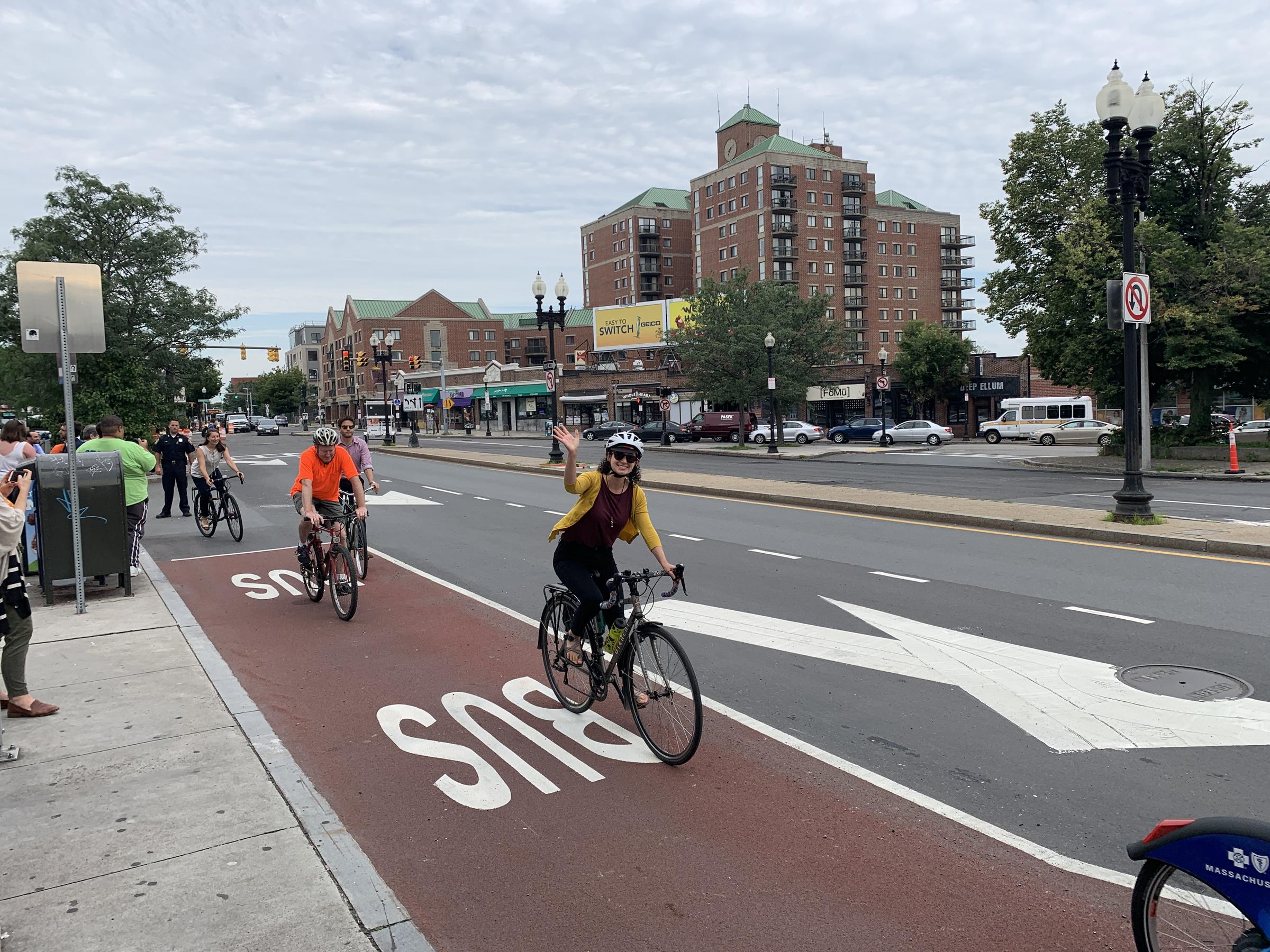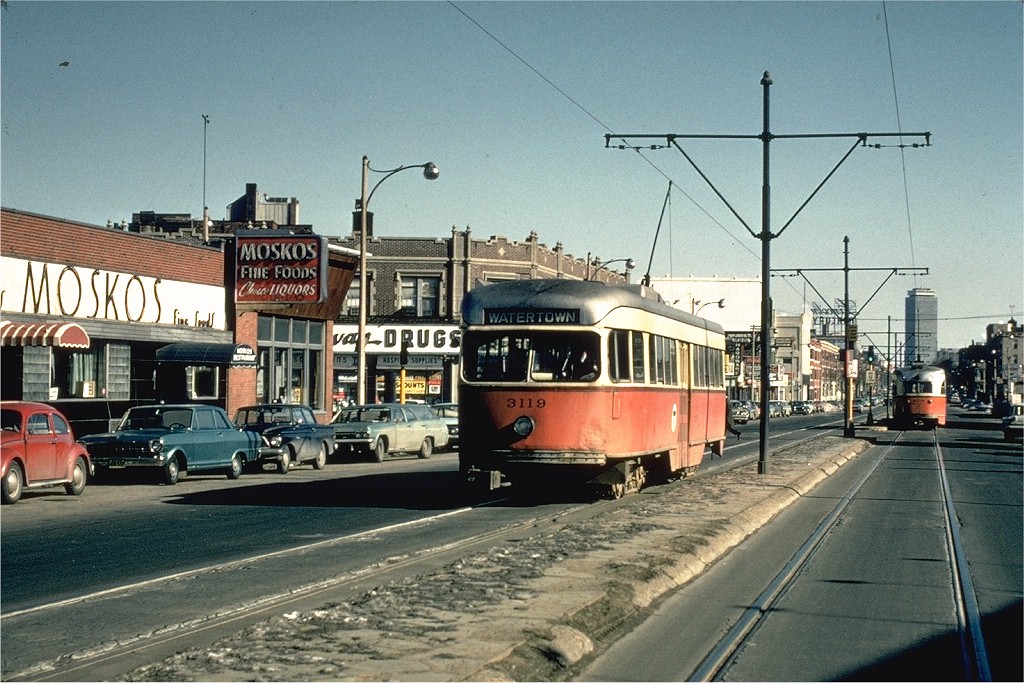Brighton Avenue Curb Extensions
Following the bus-bike priority lanes on Brighton Avenue, we’re working to extend the sidewalk to create bus bulbs at existing stops and improve the public realm.
More than 14,000 MBTA bus passengers travel between Union Square and Packards Corner each day on one of two MBTA routes. Through curb extensions, we aim to improve the commutes of bus passengers and the 1,300 daily bike riders along this key corridor. We also hope to improve pedestrian safety and walkability in Allston Village. Learn more about the project below.
Why add curb extensions
Why curb extensions
High ridership
Brighton Avenue is a key corridor for bus passengers. It serves MBTA Routes 57/57A and 66, two of the system’s highest ridership routes. High ridership warrants expansion of current stops. That's true particularly in wake of COVID-19. Curb extensions will support the ridership of today and the future. They will allow buses to save time by “bumping out” the curb to meet the bus-bike only lanes, creating in-lane boarding.

Safety and accessibility
Brighton Avenue curb extensions will introduce intersection safety measures. These will improve walkability and introduce complete ADA accessibility to bus stops and crossings. Curb extensions reduce crosswalk distances. We can lower the likelihood of pedestrian accidents by putting persons out in front of objects that may obstruct driver visibility.

Go Boston 2030
The new bus lane aligns with the Go Boston 2030 goals of:
- providing consistent, on-time service
- Safer, stress free walking and biking, and
- prioritizing the movement of people over cars.
Public realm opportunities
Allston Village Main Streets was identified as a priority project for creating walk- and bike-friendly roads in Go Boston 2030.
This project aims to return nearly 5,000 feet of sidewalk space to the public realm. This will give us the chance to allocate added space to enhance pedestrian and cycling experiences in Allston Village.
We want to introduce placemaking elements into the design of the curb extensions. We also plan to dedicate space for other future features.
Our Transit Team wants to hear the Allston-Brighton community. Please provide us your input on how we can enhance the public realm:
Project history
In 2016, the Boston Region Metropolitan Planning Organization identified the Brighton Avenue corridor between Cambridge Street and Harvard Avenue as being a priority for installing a bus-only lane. The following year, Go Boston 2030’s Action Plan designated the creation of rapid bus service on Brighton Avenue as a priority project.
In March 2019, Mayor Walsh announced the creation of a new bus lane along Brighton Avenue for peak morning service. A bus-bike only lane opened on the eastbound side of Brighton Avenue in summer 2019. This was followed by a bus-bike only lane on the westbound side in the fall 2019.
Community groups helped us collect feedback on bus service from riders and community members, including:
- Allston Main Streets
- Allston-Brighton Health Collaborative, and
- LivableStreets Alliance.
Our Transit Team conducted outreach to businesses along both sides of Brighton Avenue. We're working to put in place curb extensions on this corridor in spring 2021. Wee will continue to reach out to residents and the public for their feedback. We will also engage local community groups and businesses located along the corridor.
The section of Brighton Avenue that includes the bus/bike-only lanes was once a part of the Watertown Branch trolley. This trolley was the "A" branch of what is today's Green Line. The trolley traveled:
- underground from Park Street Station to Kenmore Station
- above ground along a separated central median from Kenmore to Packards Corner, and
- was street-running, mixed with traffic, between Packards Corner and Watertown Yard.
The trolley was taken out of operation in 1969, at which point it was replaced with today's 57 bus route. The tracks were finally removed in 1994.
Bus-Bike Lanes: The Results
After a year of improved public transit priority on this corridor, we are looking at how these facilities performed. Evaluation for these facilities precludes any data collected following the start of COVID-19.
The eastbound or inbound bus lane resulted in an increase in the amount of bus passengers throughout the four stops along Brighton Ave:
- 137 passengers in the morning peak hour, or a 5.3% growth from pre-implementation, and
- 132 passengers in the evening peak hour, or an 8.1% growth
This growth includes the MBTA bus routes 57, 57A and 66, between fall 2018 and fall 2019. There will be further analysis when data becomes available. We will analyze the impact of the westbound bus lane on peak period bus ridership.
Bicycle counts taken before and after the addition of the eastbound bus-bike lane revealed an increase in ridership. From October 2017 to September 2019, the eastbound section of the corridor saw:
- 23% average increase in the peak morning ridership
- 68% average increase for peak evening ridership
The mode share of transportation along this corridor shifted towards cycling:
- 20% to 24% of all users riding a bicycle in the morning peak
- 6% to 9% in the evening peak from pre- to post-implementation
The mode shifts shown here contribute to our Go Boston 2030 goals of prioritizing alternative modes of transportation.
We plan to measure the impact the westbound bus-bike lane has on bike ridership on this corridor when we have that data. Learn more about how bike ridership data is collected by the City.
Aerial of Brighton Ave Bus-Bike Lanes
Get involved



